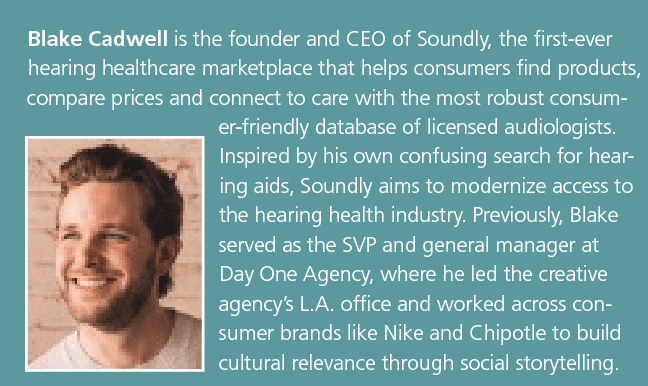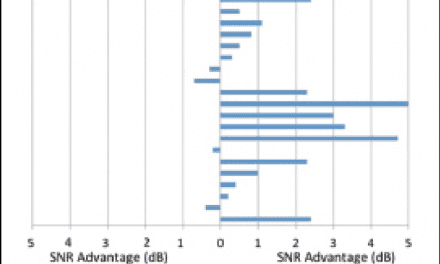Inside the Research | December 2022 Hearing Review
Consumer hearing aid shopping and comparison website will help consumers and drive AuD referrals
By Kathryn Sutherland
Kathryn Sutherland: Today, I am meeting with Blake Cadwell, CEO of Soundly, a hearing aid comparison and shopping website. Welcome, Blake. I know you started Soundly because you have a hearing impairment. Can you share your story?
Cadwell: Soundly launched in late May of this year. Precisely as you said, it was inspired by my own experience. I have a hearing loss that’s shared by my mom and brothers, hereditary hearing loss that I’ve had probably my whole life. I became aware of it when I was in junior high. At that time, I didn’t want to do anything about it, and then I didn’t want to do anything about it through my 20s. And, as my 30th birthday approached two and a half years ago, I finally decided it was time. My mom wears hearing aids and she has for 25 years, and my brother, who’s younger than me, started wearing hearing aids when he was 11. So, I’ve been around it.
When I started the process of researching hearing aids as a consumer, to figure out what my options were, and what would be a good fit for my lifestyle and needs, it was incredibly confusing. I had 15 tabs open, and it probably took me 8-12 hours to figure out which way was up. I was seeing the traditional options offered by local audiologists available on Yelp. And then, on the other end of the spectrum, I saw products being advertised to me for $99 or $200. And figuring out what the differences were, why they were so different, and what felt like a fit for me, took me quite a while.
Soundly is created to help with that first 8-12 hours and really help people understand their options. What can you do? Where can you go if you’re interested in a prescription? What are your options for OTC? How do you compare those side by side and what do you think about them? That is really what Soundly is meant to do.
Sutherland: How did you come to your resolution when you were going through that introductory stage of finding what device would work for you? Where did that lead you?
Cadwell: I think it’s interesting that the conversation evolves around OTC. I had an experience where I bought a hearing product online. I tried the product on, and I walked — I live in Los Angeles, and as soon as I walked out of my house, I ducked because I heard a helicopter and I thought it was on top of my house, and of course, it was in the sky. But it was very visceral and very loud, and I know many people may have this experience.
I have cookie-bite hearing loss. Your readers would understand that is less common and harder to treat and doesn’t come in the normal schemas that are put into some online hearing aids.
For me, a product that didn’t have as much customization as I needed really wasn’t working for me. So, I sent it back, and I went to a traditional audiologist, and I got fitted with my daily wear. I’ve tried dozens of hearing aids now, but my daily wear is a ReSound One 9 product. I think that experience taught me how important professional care is. It’s critical, especially as people start. There are other products on the market that are more suited and more customizable than the one that I tried originally. But still, I think a lot of folks are going to need that professional layer. And that’s certainly something that I know is a conversation in the audiology community.
Sutherland: Yes, I agree. When people come to Soundly, what can they expect?
Cadwell: We’re assuming that folks who are coming to Soundly are in one of two groups. Either they’re just getting started and maybe they’ve waited for years, and they finally said, ‘Okay, I’m going to do it.’ They were me two and a half years ago, and after thinking about it for a decade, ‘This is the day I’m going to look into this and get to the bottom of it.’ And then the other group would be folks who have had hearing loss or hearing aids for a long time and are looking to find information about the latest technology, or they’re curious about what all the news they’re seeing could mean for them, and what new opportunities might be available.
In either case, those folks are given a number of different tools. One of the primary tools would be within the shopping experience. They can use tools to sort all the available products on the market today that come from major manufacturers and major OTC players and see them side by side. They can look at prices. They can look at reviews. They can look at functionality. We have a compare feature that puts it all in a stack where you can see which ones are Bluetooth enabled, which ones are rechargeable, and then, of course, the price for each one and how many reviews there are. And then you can drill down into individual products and read a whole lot more about those products. We work with audiologists to get their opinion on each one of the products. If you scroll to the bottom of any product on soundly.com, you’ll see an audiologist’s take, and those folks are unbiased. They don’t care which product you go with; they offer their insight into which products are suitable for which people.
We also have a hearing test, which takes about five minutes. I’m biased, but I think it’s one of the simplest user experiences out there. The results are provided in an actual audiogram chart, which we feel is important for folks to see. At the top right of the hearing test, it says, ‘You need to get a real, professional hearing test if you want to really understand your results.’ This will give you a directional understanding, and we also have within that hearing test questions around the red flags. We’ve worked with audiologists to ensure that all of those are noted, and if someone says ‘yes’ to any of the red flags, we give them an immediate option to go see a local care professional.
And that leads me to the other piece that people can access through soundly.com and that is the care database. If you’re someone who says, ‘I don’t want to start with the product, and I don’t need a hearing test right now.’ Then you can go straight to a local care provider and talk to someone. Site visitors can go to the ‘Find Care’ tab and just type in their zip code. We’ve worked with some amazing technologists who have pulled reviews from multiple sites so you can see it all collapsed into one. You can find an audiologist in your area. You can see their latest reviews, where they are on the map, and then, obviously, their up-to-date contact information which links out to their website.
Sutherland: It is a great feature and benefit to both the consumer and hearing care professional. I did see that you work with audiologists. What are their backgrounds?
Cadwell: They’re all practicing audiologists and they’re speaking from both a care perspective and as experts on the technology that’s within these products. Each of them has experience fitting various products. I think some of the products, like Eargo for example, audiologists wouldn’t have experience fitting that because that’s not the channel for Eargo. They do have experience talking to patients about that, fielding questions, and then, of course, reviewing the technology itself.
Sutherland: Where do you anticipate the growth of your site will come from?
Cadwell: I’m not sure. I think it’ll be interesting to see. Today it seems that the best outcomes are still coming from folks who are in touch with a professional. I look at companies like Lively under the GN Group, that model to me is very interesting because they bring in the professional layer of care and programming, and they’re supporting folks through calls and follow-ups and all the things you might need. Many of our readers end up finding a local care provider. They want someone who can give them hands-on support and ultimately help them with products. I think the question is probably more about what technology will arise in the next handful of years that gives consumers more control.
Sutherland: Do you have plans for future product expansion, like adding accessories or disposables?
Caldwell: Yes, we have thought about accessories. I would imagine we’ll do it at some point. I think the key for us at this stage is we really want to keep the consumer experience at the forefront and keep it clean so that when consumers are coming with their most important problem, which is trying to navigate the space.
Sutherland: I can see the potential in the referrals being sent to hearing aid clinics. How is that going? Are you tracking the referrals? Have audiologists communicated back to you about the referrals that come from Soundly?
Caldwell: Yes, absolutely. I think in terms of just the consumer behavior, which is what I have the most visibility into. I can see how folks are interacting with the site. We see one of the most common behaviors is folks will do a lot of research on different products and what’s available to them. And then they’ll go up to that ‘Find Care’ tab, they’ll find a local audiologist.
We can see that that’s happening thousands of times every month. And so presumably, a lot of these local clinics are receiving inbound calls from folks who have had a chance to become educated and maybe feel more comfortable with the options that exist for them.
We do get a lot of feedback from consumers asking, ‘How do I know what price I’m going to get locally’ I think that is one thing that the industry will continue to have to grapple with, is pricing. As OTC rolls out, we’re going to see flat pricing on OTC. And if you have unlisted pricing on prescriptions, I think it’s an interesting dynamic for the consumer.
Sutherland: That’s wonderful and a great benefit for audiologists and hearing aid dispensers. Do you have anything else that you would like to share?
Caldwell: The piece that I feel so strongly in the transition from whatever the historical models have been to the emerging models, is that care, whatever form that comes in, is an essential part of hearing wellness and the hearing health process.
I know I’ve experienced that personally. I know how important it has been for me to have someone talk me through things. And I don’t know where I sit percentage-wise; I’m very educated on all of the options that exist for me. I’ve spent a lot of time researching this and I’m very tech-savvy. And so, you imagine folks that are not in that position, how the importance of care, I think, has to come through in whatever the models of the future are. And I certainly feel that for the audiology community.
The only other thing I would note to you is, we’re going to be announcing a partnership with a company called Tuned. Tuned is a platform. Their primary focus is bringing audiological care to employers, so employers who want to offer it as a benefit to their employees can connect. I think they have 180 audiologists on their platform currently. It’s all done through telehealth.
We are forming a partnership with them that I think will be interesting. They’re going to help create some content that will be educational for our users. And then if folks are interested in talking to a licensed audiologist before they decide how to move forward, they can get in touch with Tuned. It will be coming out in the next couple of weeks, and I’m really excited about it.
Sutherland: That sounds great. I’m very excited for you and very excited for your company and for the consumers that you’re going to help.
Caldwell: Thank you. I appreciate the kind words and I’m looking forward to the editorial.

Citation for this article: Sutherland K. Interview with Blake Cadwell, CEO of Soundly.com. Hearing Review. 2022;29(12):14-15.



